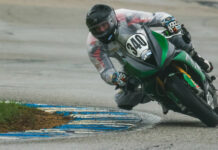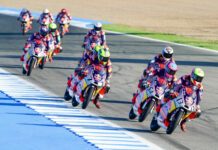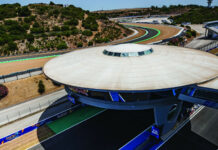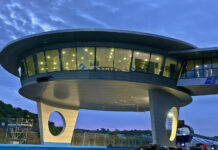The PPIHC Provides Clarification on the Decision to Revert to a Handlebar Rule Last Used in 2012
COLORADO SPRINGS, COLO. – Motorsports in general are inherently dangerous and the Pikes Peak International Hill Climb is one of the most dangerous in the word. As the organizers of the PPIHC, an event that was founded in 1916 and will celebrate its 100th anniversary next summer, it is our responsibility to minimize risk while preserving the rich legacy of the Race to the Clouds. One way of minimizing these risks is by not allowing vehicles to compete in our race that we are not comfortable with.
A recent article first published by RoadRacingWorld.com regarding the PPIHC’s decision to revert to a rule last used in 2012 that eliminates motorcycles manufactured with two-pieced handlebars from competing in the 2016 race has captured the attention of countless others, but with a few misconceptions. We wrote this release to eliminate any confusion. We appreciate everyone’s interest in the PPIHC and wanted to explain the history of motorcycle racing at Pikes Peak and reasoning behind why we decided to reestablish this rule for motorcycles participating in the Race to the Clouds.
PPIHC MOTORCYCLE HISTORY
•1916
o1916 – Motorcycles and sidecars compete in inaugural PPIHC race.
•1954 & ’55
o1954 – Motorcycle racing returns to the Hill Climb for the first time in 38 years.
o1956 – Motorcycle racing is not included in the PPIHC racing program for the second time.
•1971-76
o1971 – After a 16 year absence, motorcycle racing returns to the PPIHC and becomes an annual affair.
o1976 – Three motorcycle competitors are injured in an incident at the summit on Race Day during the sixth consecutive year of two-wheeled competition.
– The incident lead to the third suspension of the motorcycle program starting with the 1977 race.
•1980-82
o1980 – The motorcycle program is once again reinstated.
o1982 – Motorcycle competitor Bill Gross Jr. dies during Race Day competition. Gross’ death marks the first Race Day fatality in 60 editions of the Hill Climb and the second death associated with the race.
– Gross’ death leads to the motorcycle program being suspended for a fourth time starting with the 1983 race.
•1991-Present
o1991 – Wally Dallenbach Sr. revives motorcycle competition at the PPIHC under the guise of his annual mountain motorcycle ride, the Colorado 500.
o1992 – After a successful inaugural year of the Colorado 500 being affiliated with the PPIHC the ride is scheduled to bring two-wheeled racing back to America’s Mountain in ’92. The Colorado 500’s involvement in the PPIHC was canceled when the required number of entries had not been compiled by May 31st, suspending motorcycle racing at the hill climb for a fifth time.
– After hearing bikes will not return in ’92 Sonny Anderson and Bill Brokaw decide to take matters into their own hands. Anderson and Brokaw work with the American Motorcyclist Association to ensure insurance coverage for the motorcycle competition, the Hill Climb Association’s main reason for not including motorcycles in the race, and attract a field of 57 competitors in less than two months.
o2013 – The PPIHC makes an addition to the PPIHC Rule Book that would allow motorcycles with two-piece clip-on style handles for the first time in the race’s 97 year history.
o2014 – Motorcycle competitor Bobby Goodin dies after a Race Day crash at the summit on a bike utilizing two-pieced handlebars.
o2015 – Motorcycle competitor Carl Sorensen dies after a practice day crash on a bike utilizing two-pieced handlebars.
– To avoid canceling the motorcycle program for the 100th Anniversary PPIHC race in 2016, the PPIHC’s Race Committee and Board of Directors votes to repeal the rule permitting two-piece clip-on style handles.
PRESENT DAY
The PPIHC is 100 percent committed to maintaining the Race to the Clouds as a premier two and four-wheeled racing event by honoring our rich history while developing and working to secure a sustainable and prosperous future. The PPIHC is one of, if not the most, unique motorsports events in the world with everything from sidecars, quads/ATVs, motorcycles, production vehicles, semi-trucks, and 1,400+ horsepower Unlimited and electric racers being able to compete in the same event on the same day.
Pikes Peak – America’s Mountain is a breathtaking (in more than one way) and incredibly unique venue for motorsports. The PPIHC race course starts at an elevation of 9,390ft. (2,862m.) and consists of 156 turns and 1,000+ft. (304.8+m.) cliffs across a 12.42 mile (19.99km) stretch of pavement, all leading to the 14,115ft. (4,300m.) Finish Line; the highest in motorsports. Many have said the only way you can accurately describe the PPIHC’s iconic race course to those unfamiliar with it is by picking up the Nürburgring’s Nordschleife and placing it on the side of a 14,000+ft. (4,267.2+m) mountain, but only after removing all run-off area’s and all but nine relatively short guardrails.
Motorcycle racing was banned from the Nordschleife in 1995 as it was deemed too dangerous.
As Megan Leatham, PPIHC Executive Director, stated in the RoadRacingWorld.com article:
“Although we understand that PPIHC [racing] is inherently dangerous and deaths and injury may occur regardless of what type of bike someone is riding, the decision to make it mandatory to have one-piece handlebars was made based upon the type of bike the committee and BOD is comfortable allowing to race Pikes Peak.
“Once the Committee and BOD determined to keep the motorcycle program in place, changes regarding the bike program had to be made. One common factor in both fatalities [Bobby Goodin, 2014; Carl Sorensen, 2015] was the type of bike both competitors were riding and the BOD is no longer comfortable allowing that type of bike on Pikes Peak.”
Jim Vidmar, PPIHC Assistant Director of Competition, also stated the RoadRacingWorld.com article:
“We are striving to strike a balance that will allow motorcycles to continue to compete on Pikes Peak but minimize the risk as much as possible. We are fully aware we will never eliminate the risk completely, but we are taking steps to make the race as safe as possible.”
These statements may require further clarification.
The rule in question is 6.K in the Motorcycle/Quad/Sidecar Division Safety & Construction; Technical Regulations and Special Rules from the 2016 PPIHC Rule Book:
“6. Motorcycles –
K. Only motorcycles manufactured with one piece handle bars as original equipment will be permitted. Only OVM one-piece handlebars will be permitted. This Rule does not apply to bikes in the Pikes Peak Challenge Sidecar Class.”
First off, in no way are we, the PPIHC, saying that this adjustment to the PPIHC rule book will make the race safe. Racing is inherently dangerous in general and even more so at the PPIHC, especially without the protection of safety harnesses and a roll-cage. The only way we could make motorcycle racing at Pikes Peak safe is by banning them for a sixth and final time; however, this is in no way the direction we want the race go and we are fully dedicated to keeping the motorcycle program as a key part of the Race to the Clouds by preserving and maintaining their role in the race’s history.
If you look at the history of motorcycle racing at the PPIHC, the motorcycle program has been banned once due to an incident that injured three and once again after a fatality. There is no way for us to let everyone know how committed we are to preserving motorcycle racing at the PPIHC than through our actions to only acquire an insurance provider, in today’s litigious society, that would permit two-wheeled competition after two consecutive years of motorcycle competitor fatalities.
To clarify, nowhere in the PPIHC Rule Book does it state that sportsbikes are not allowed to compete at the PPIHC. Competitors are more than welcome to apply for an invitation to compete in the PPIHC with a sportsbike as long as it was produced by the manufacturer with one-piece handlebars and the original handlebars are used.
One key reason the PPIHC Race Committee and Board of Directors are only comfortable allowing motorcycles originally produced by manufacturers with top mounted one-piece handlebars is the vertical riding position and high vantage point these bikes encourage; motorcycles equipped with clip-on style handles encourage a crouched, horizontal riding position and low vantage point in comparison. The Pikes Peak Highway is an extremely unique race course with many crests and the potential for wildlife like deer, big horn sheep, and even bear to also be on the race course while riders ascend to the mountain’s summit. Due to limiting factors associated with a rider’s ability to see and react as early as possible to these and countless other unpredictable conditions found at Pikes Peak, the PPIHC is no longer comfortable with the riding position and vantage point associated with and encouraged by motorcycles equipped with two-piece clip-on style handles.
Another benefit to top mounted one-piece handlebars when reacting to unpredictable conditions is their length. In most cases, one-piece handlebars provide a considerably wider reach in comparison to clip-ons. Both handlebars and clip-ons are essentially levers and as levers get longer, less force is required to make them pivot at their fulcrum. When a rider needs to react to something quickly, having these typically longer handlebars makes it easier for them to do so.
The debate over what is better or safer in regards to top mounted one-piece handlebars and clip-ons is a matter of personal preference and comfort; while the PPIHC does understand this, we are only comfortable allowing competitors to compete with motorcycles originally produced by manufacturers with top mounted one-piece handlebars for the above reasons. We understand not all riders are comfortable on bikes with top mounted handlebars and do not want our competitors to be uncomfortable when competing in the PPIHC. Anyone that accepts an invitation to participate in the PPIHC, both on a motorcycle or in a car, needs to be comfortable with their vehicle; if they are not we respectfully ask them to decline the invitation.
One common misconception is that this rule change was made in an effort to slow motorcycles down but this is not accurate. This year the CC limit for the Pikes Peak Heavyweight Division (formerly known as Pikes Peak Open and Pikes Peak 1205cc) was actually increased from 1205cc to 1305cc, allowing motorcycles that had the potential to be extremely competitive but were ineligible in 2015, eligible for 2016. It should also be noted that the two fastest motorcycle times in PPIHC history were recorded on bikes with top mounted one-piece handlebars.
Another change to reduce risk at the PPIHC starting in 2016 race is the decision to reduce the total number of entries to approximately 100 competitors, with a projected field of 67 four-wheeled entries and 33 two-wheeled entries. Every year we ask for competitor feedback and two of the most common subjects we received it on in 2015 were Race Day being too long and competitors not getting enough practice time on the mountain. By reducing the field and creating this split we should be able to have an efficient event on Race Day and provide competitors with more practice time throughout Race Week.
We are constantly working to make this race better and every year we brainstorm and implement safety improvements to reduce risks associated with it. A specific motorcycle example came in 2014 when American Honda, the AMA, Motorcycle Roadracing Association, Roadracing World Action Fund and the PPIHC partnered to deploy soft barriers at two corners that are traditionally known for motorcycle crashes. The soft barriers proved their value immediately when Jeremy Toye crashed his sportbike at the end of Halfway Picnic Ground, the fastest quarter-mile of the PPIHC race course, during the first practice session with the barriers in use. Toye was able to walk away uninjured after hitting the barrier and would go on to win the overall motorcycle title just days later. You can read about it here.
Finally, as a one day event that takes place only once a year we only get one opportunity a year to try new things and get everything right. The PPIHC is dynamic and just anything making improvements is a process, we just have one chance to test and try ours. In 2013, we tried something new and made a decision to allow something that had never been permitted in 97 years of racing at Pikes Peak by making motorcycles equipped with two-piece clip-on style handles eligible for competition. There have now been three races with this rule in effect and at this time we did not see this adjustment as something that was beneficial to the motorcycle program and PPIHC in general.
The history and tradition of motorcycle racing at Pikes Peak is dominated by bikes with top mounted one-piece handle bars and out of 37 PPIHC motorcycle races there have only been three that included anything different. The road used to be completely dirt and once it was fully paved we decided to try something different, but now after having tried it we have come to the conclusion that it wasn’t a good fit. Moving forward, we are excited to get back to our roots with only one-piece top mounted handlebars being permitted for competition while serving a previously untapped niche in the world of motorcycle racing as the only international paved motorcycle road race to provide a stage for manufactures to demonstrate the performance capabilities of these incredible bikes.
We hope to see you on Pikes Peak – America’s Mountain on Sunday, June 26, 2016 for the 100th Anniversary of the Race to the Clouds!






